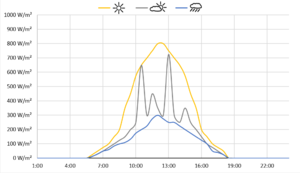Insolation
Insolation is a measurement used to quantify the amount of solar energy that a location receives during a specified period of time (daily, monthly, yearly). Irradiance is a term that is also frequently used in the PV field, but irradiance refers to an instantaneous measurement of power. Insolation is typically expressed in kWh/m². 1 kWh/m² can be expressed as 1m² receiving sunlight with a irradiance (sunlight intensity) of 1000 W/m² for 1 hour. Insolation may also be referred to as Peak Sun Hours (PSH) - both represent the same thing. The average insolation value for a given location will largely determine the amount of energy that a PV system produces, therefore it is a very important value for PV system design. Insolation values are based upon real world testing and observation and can be calculated for a particular day as follows:
Daily insolation = sum of hourly insolation values ÷ 1000
- Example 1: An irradiance testing station gives you the following data for a particular day. What is the insolation value for this day?
Time 8:00 9:00 10:00 11:00 12:00 13:00 14:00 15:00 16:00 17:00 Hourly insolation values 200 Wh/m² 300 Wh/m² 500 Wh/m² 800 Wh/m² 1000 Wh/m² 1000 Wh/m² 800 Wh/m² 500 Wh/m² 300 Wh/m² 200 Wh/m²
- Daily insolation = (200 + 300 + 500 + 800 + 1000 + 1000 + 800 + 500 + 300 + 200) W/m² ÷ 1000
- Daily insolation = 5600 Wh/m² ÷ 1000 = 5.6 kWh/m²
Estimating PV production with insolation
The power rating of PV modules is determined by testing under standard test conditions, one of which specifies that the test be performed with light of an irradiance (sunlight intensity) of 1 kW/m² (1000 W/m²). A basic calculation of energy production for a PV system can be performed using the power rating of the PV source and the insolation value for the location during a given period.
Note: additional PV module loss factors must be taken into account to arrive at a realistic estimate of production under real world conditions. The losses due to these factors can be substantial.
| PV source production estimate | = PV source power rating × Insolation |
|---|
- Example 1: You have a 100 W PV module. It will be installed in a location without shade that has an average daily insolation value of 4kWh/m². Without accounting for loss factors, how much energy could this module generate on average per day?
- PV source production estimate = 100 W x 4 kWh/m²
- PV source production estimate = 400 Wh
- Example 1: You have a 100 W PV module. It will be installed in a location without shade that has an average daily insolation value of 4kWh/m². Without accounting for loss factors, how much energy could this module generate on average per day?
